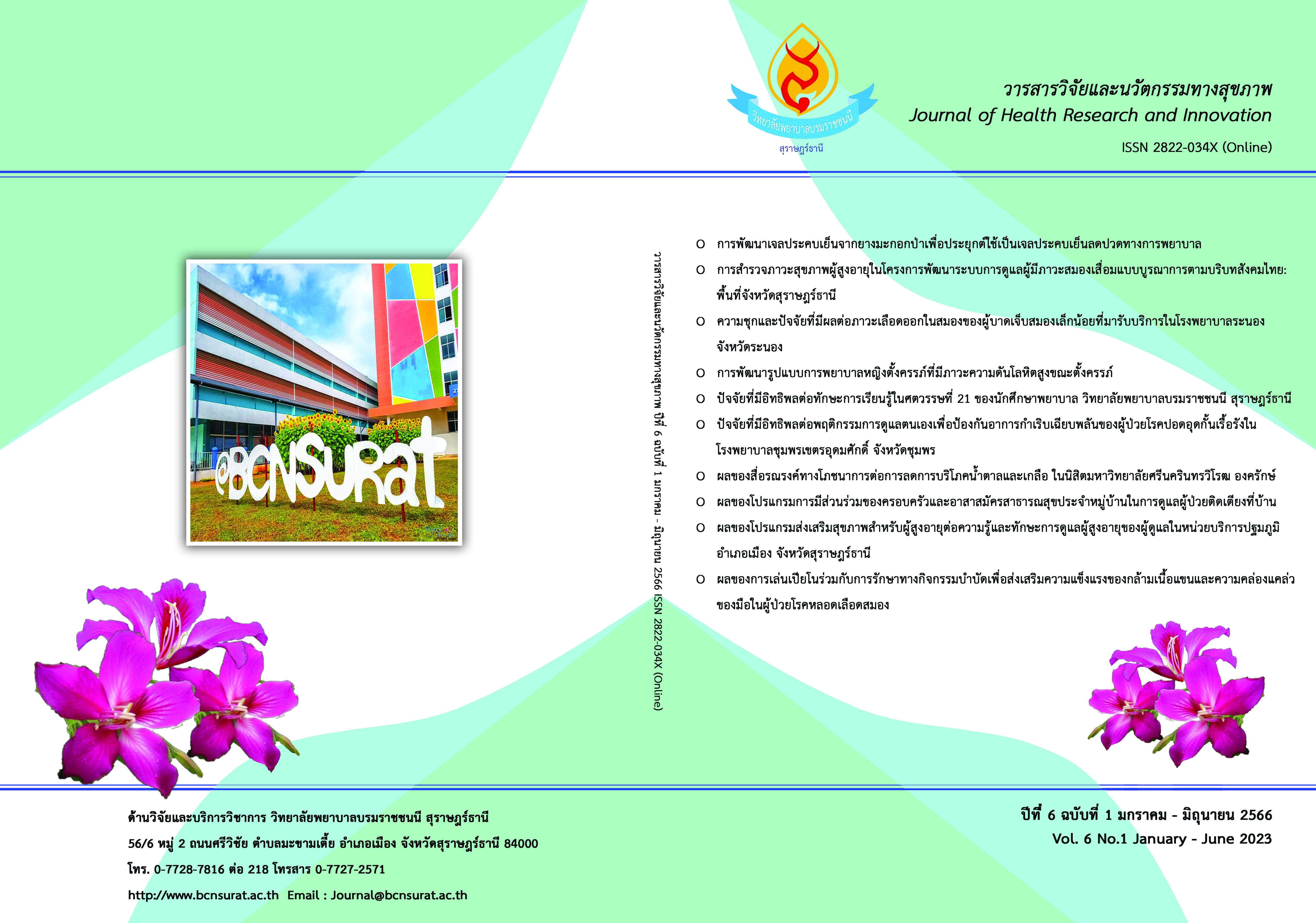การพัฒนาเจลประคบเย็นจากยางมะกอกป่าเพื่อประยุกต์ใช้เป็นเจลประคบเย็นลดปวด ทางการพยาบาล
คำสำคัญ:
เจลประคบเย็น, ยางมะกอกป่า, การลดปวดบทคัดย่อ
การวิจัยครั้งนี้เป็นการวิจัยและพัฒนา มีวัตถุประสงค์เพื่อศึกษาสภาพปัญหาและความต้องการ การพัฒนาเจลประคบเย็นจากยางมะกอกป่าเพื่อลดปวด และประเมินประสิทธิผลของเจลประคบเย็น รวมทั้งประเมินความพึงพอใจของผู้ใช้นวัตกรรมเจลประคบเย็น การดำเนินการ 3 ระยะ ได้แก่ 1) การศึกษาสภาพปัญหา ผู้ให้ข้อมูล คือพยาบาลวิชาชีพประจำหอผู้ป่วยและอาจารย์พยาบาล รวมทั้งหมด 10 คน เครื่องมือที่ใช้คือแบบสัมภาษณ์กึ่งโครงสร้าง เก็บรวบรวมข้อมูลด้วยวิธีการสนทนากลุ่ม วิเคราะห์ข้อมูลด้วยการวิเคราะห์เชิงเนื้อหา 2) การพัฒนานวัตกรรมเจลประคบเย็นจากยางมะกอกป่าโดยผู้วิจัยและผ่านผู้ทรงคุณวุฒิตรวจสอบคุณภาพ 3) ประเมินประสิทธิผลของเจลประคบเย็นจากยางมะกอกป่า และความพึงพอใจจากกลุ่มตัวอย่าง คือ พยาบาลวิชาชีพจำนวน 15 คน เครื่องมือที่ใช้ประกอบด้วยนวัตกรรมเจลประคบเย็นจากยางมะกอกป่า แบบประเมินความปวด แบบประเมินความพึงพอใจในการใช้งานนวัตกรรม วิเคราะห์ข้อมูลทางสถิติโดยใช้ความถี่ ร้อยละ ค่าเฉลี่ย ส่วนเบี่ยงเบนมาตรฐาน และสถิติ Wilcoxon Sign Rank Test
ผลการศึกษาพบว่า 1) เจลประคบเย็นในทางการค้ามีราคาสูงและมีจำนวนไม่เพียงพอต่อการใช้งาน เจลประคบเย็นบางชนิดมีประสิทธิผลในการถ่ายโอนอุณหภูมิต่ำมีผลต่อการลดปวด และมักเกิดผลึกน้ำเมื่อแช่เย็นจนแข็งตัว และเกิดการเสียสภาพในระหว่างการเก็บรักษา รวมทั้งมีขนาดสำหรับการใช้งานจำกัด ไม่มีขนาดที่เหมาะสมกับผู้ป่วยในแต่ละราย 2) นวัตกรรมเจลประคบเย็นจากยางมะกอกป่าที่พัฒนาขึ้นมีหลายขนาดเหมาะสมกับการใช้งาน 3) การเปรียบเทียบก่อนและหลังการใช้เจลประคบเย็นจากยางมะกอกป่าสามารถลดอาการปวดอย่างมีนัยสำคัญทางสถิติ (p<.05) และกลุ่มตัวอย่างมีระดับความพึงพอใจโดยรวมอยู่ในระดับมาก (Mean=4.54, SD.= .31)
ผลการวิจัยครั้งนี้แสดงให้เห็นว่าบุคลากรทางสุขภาพสามารถใช้นวัตกรรมเจลประคบเย็นจากยางมะกอกป่ามาเป็นอีกทางเลือกหนึ่งที่สามารถนำมาใช้ในการจัดการความปวดในผู้ป่วยที่มีความผิดปกติของกล้ามเนื้อ กระดูกและข้อ
เอกสารอ้างอิง
Bleakley, C., Donough, S., Gardner, E., Baxter, G., Hopkins, J., & Davison, G. (2012). Cold-water Immersion (cryotherapy) for Preventing and Treating Muscle Soreness Exercise. Cochrane Database of Systematic Review. Retrieved Oct 12, 2022, from; https://doi.org/10.1002/14651858.CD008262.pub2
Bora, N. S., Kakoti, B. B., Gogoi, B., & Goswami, A. K. (2014). Ethno-medicinal claims, phytochemistry and pharmacology of Spondias pinnata: A review. International Journal of Pharmaceutical Sciences and Research, 5(4), 11-38.
Canadian center for occupational health and Safety. (2014). Work-related Musculoskeletal disorders (WMSDs). Retrieved Oct 5, 2022, from; http://www.ccohs.ca/oshanswers/diseases/rmirsi.html.
Cao, Q., Peng, B., Wang, L., Huang, Y., Jia, D., Jiang, H., Lv, Y., & Huang, D. (2021). Expert Consensus on The Diagnosis and Treatment of Myofascial Pain Syndrome. World journal of clinical cases, 9(9), 2077–2089.
Chaimanee, A., & Ekburanawat, W. (2020). Occupational toxicology (5th ed.). Chonburi: Summacheeva Foundation. (in Thai)
Chaiyalert, P., NetIamPhum, T., & Chuenphapai, A. (2023). Innovative self-made cold compress gel for reducing pain and swelling. Retrieved Mar 5, 2023, from; https://kpsoffice.kps.ku.ac.th/doc/km/km_nurse.pdf
Charoenbhakdi, J., & Homla, W. (2021). An innovative “ Wonder Cold Pad for pain relief ” in patients with orthopedic surgery. Thai Journal of Nursing, 70(3), 20-28. (in Thai)
Churit, K. (2022). Innovation “Perineal cold jel for comfort care” Retrieved Mar 5, 2023, from; https://www.hospital.tu.ac.th/ndtuh/upload/addsome/files/2022032415094916.pdf
Crabtree, B.F., & Miller, W.L. (1992). Doing Qualitative Research. London: SAGE.
Eamchunprathip, S., Sae-Sia, W., & Khupantavee, N. (2012). Application of cold-press massage to exercise programs and Its effects on patients’ recovery from total knee replacement surgery. Thai Journal of Nursing Council, 27(1), 77-90. (in Thai)
Jaikawin, P. (2009). Design and synthesis of blended hydrogels sheets for biomedical use as wound dressings. Unpublished master’s thesis, Chiangmai university, Chiangmai. (in Thai)
Jaiphakdee, k. (2016). The effect of postoperative pain management program by using aromatherapy and music therapy in postoperative patients with open reduction internal fixation of leg. Journal of Charoenkrung Pracharak Hospital, 12(2), 54-68. (in Thai)
Konno, K. (2011). Plant latex and Other Exudates as Plant Defense Systems: Roles of Various Defense Chemicals and Proteins Contained Therein. Phytochemistry, 72(13), 1510-1530.
Laksemi, D. (2019). Biological Activity of Spondias pinnata: A Review. Indonesia Journal of Biomedical Science, 13(2), 88-93.
Markman, D., Gewandter, S., & Frazer, E. (2020). Comparison of a Pain Tolerability Question With the Numeric Rating Scale for Assessment of Self-reported Chronic Pain. JAMA Network Open. 3(4). doi:10.1001/jamanetworkopen.2020.3155
Melzack, R., & Katz, J. (2004). The Gate Control Theory: Reaching for the brain. In T. Hadjistavropoulos & K. D. Craig (Eds.). Pain: Psychological perspectives (pp. 13-34). Mahwah, NJ: Lawrence Erlbaum Associates.
Ministry of Public Health. (2018). Report on the situation of diseases and health hazards from occupations and the environment. Division of Occupational and Environmental Diseases. Retrieved Dec 28, 2022, from http://envocc.ddc.moph.go.th/uploads/situation2/2561/2561_01_envocc_situation.pdf
Mishra, S., & Sarkar, K. (2021). Work-related Musculoskeletal Disorders and Associated Risk Factors Among Urban Metropolitan Hairdressers in India. Journal of occupational health, 63(1), 1-9.
Nurcan, C., & Karadag, M. (2015). Superficial Heat and Cold Applications in The Treatment of Knee Osteoarthritis. Retrieved Oct 5, 2022, from http://dx.doi.org/10.5772/60534
Pimban, Y., Suttiart, O., & Wangkunprom, K. (2021). Effects of pain management with cold compress in patients after leg bone fixation surgery in orthopedic wards. Academic Journal of Mahasarakham Provincial Public Health Office, 5(10), 44-54. (in Thai)
Saeedi, Z., Ghorbani, N., Shojaeddin, A., & Sarafraz, M. (2022). The Experience of Pain Among Patients Who Suffer from Chronic Pain: The Role of Suppression and Mindfulness in The Pain Sensitivity and The Autonomic Nervous System Activity. Current Psychology. https://doi.org/10.1007/s12144-022-02849-x
Sameh, S., Al-Sayed, E., Labib, R. M., & Singab, A. N. (2018). Genus Spondias: A phytochemical and pharmacological review. Evidence-Based Complementary and Alternative Medicine, 2018. 1-13.
Sonkodi, B., Kopa, Z., & Nyirady, P. (2021). Post Orgasmic Illness Syndrome (POIS) and Delayed Onset Muscle Soreness (DOMS): Do They Have Anything in Common?. Multidisciplinary Digital Publishing Institute journal. 10(8). from https://doi.org/10.3390/cells10081867
Soontornchai, S. (2015). Hazard communication with GHS. Journal of Safety and Health, 8(30), 39–44. (in Thai)
Srisatidnarskul, B., (2020). Effect size, power analysis, optimal sample size calculation using G*power software. Bangkok : Chulalongkorn University Press. (in Thai)
Thai Association for The Study of Pain. (2019). Clinical Guidance for Acute Postoperative Pain Management (2nded.). Bangkok: Tana press. (in Thai)
Theerasopon, P. (2016). The innovation of invented gel pad for use in health promotion and nursing therapeutic. Journal of Phrapokklao Nursing College, 27(2), 65-77.
Trisenee, S., & Thongkam, H. (2018). Innovation “magic gel” Retrieved Mar 5, 2023, from; http://kantang-hospital.go.th/wp-content/uploads/2018/03/Inno_2.pdf
Utaisang, A., Kaewpolngam, P., Sanlad, S., Singthong, S., Jangsanam. K., Prompap, K. & et al. (2020). The effect of cold herbal gel pack compress to release post traumatic headache of patients with mild traumatic brain Injury. Srinagarind Medical Journal, 35(2), 217-223. (in Thai)
Waters L., & Raisler, J. (2003). Ice Massage for The Reduction of labor Pain. Journal of Midwifery and Women Health, 48: 317-321.
Yong, R. J., Mullins, P. M., & Bhattacharyya, N. (2022). Prevalence of Chronic Pain Among Adults in The United States. Pain journal, 163(2).
ดาวน์โหลด
เผยแพร่แล้ว
รูปแบบการอ้างอิง
ฉบับ
ประเภทบทความ
สัญญาอนุญาต
ลิขสิทธิ์ (c) 2023 วิทยาลัยพยาบาลบรมราชชนนี สุราษฎร์ธานี

อนุญาตภายใต้เงื่อนไข Creative Commons Attribution-NonCommercial-NoDerivatives 4.0 International License.
บทความที่ได้รับการตีพิมพ์เป็นลิขสิทธิ์ของวารสารวิทยาลัยพยาบาลบรมราชชนนี สุราษฎร์ธานี
ข้อความที่ปรากฏในบทความแต่ละเรื่องในวารสารวิชาการนี้เป็นความคิดเห็นส่วนตัวของผู้เขียนแต่ละท่านไม่เกี่ยวข้องกับวิทยาลัยพยาบาลบรมราชชนนี สุราษฎร์ธานี และคณาจารย์ท่านอื่นๆในวิทยาลัยฯ แต่อย่างใด ความรับผิดชอบองค์ประกอบทั้งหมดของบทความแต่ละเรื่องเป็นของผู้เขียนแต่ละท่าน หากมีความผิดพลาดใดๆ ผู้เขียนแต่ละท่านจะรับผิดชอบบทความของตนเองแต่ผู้เดียว



